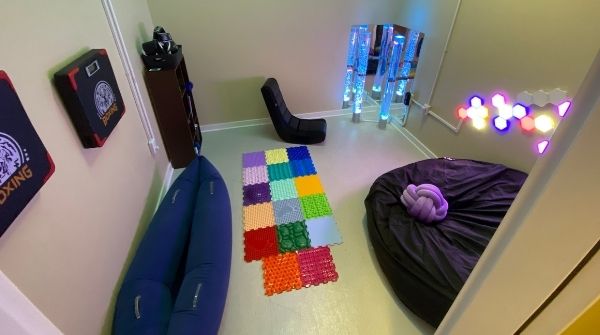New SECU YCC Sensory Room Creates Calming Oasis
The SECU Youth Crisis Center (YCC), a Monarch program, recently turned a storage room into a calming sensory room to help children better cope while receiving services during a mental health crisis.
Monarch Occupational Therapist Amanda Cadena, OTR/L, views the new sensory room at the SECU Youth Crisis Center, a Monarch program, as a chance for children to explore their sensory systems. The sensory room is a relaxed environment using therapeutic lights, sound, color and activities as ways to safely strengthen coping skills for children who are experiencing a mental health crisis.
Two YCC participants using the sensory room gave it a thumbs up. One boy said it was, “amazing” while he tried out the wall lights and boxing strength tester. Another teen enjoyed sitting in the inflatable, sensory canoe, which applies therapeutic use of deep pressure and compression, saying it instantly made him feel calm.
The sensory room helps a child to de-escalate and redirect anger and frustration. “The goal is to visit the sensory room when they need to distract their mind when they are angry or agitated,” Cadena shares, adding that through one-on-one occupational therapy (OT) in the sensory room coping skills are developed, strengthened and will more likely be used.
The YCC began incorporating OT in 2020 as way to assist youth through sensory-based coping techniques. Through her past experiences working with youth, specifically children with autism, Cadena believed creating a sensory room would be beneficial for children seeking help at the YCC.
Items and activities available in the sensory room were reviewed and inspected to address any safety concerns. A child using the sensory room sets a timer for the 20-minute limit and is able to select activities of interest. “The option of choice is what is important so that the child can decide what will calm their body down,” Cadena says, noting that a child is accompanied by either the OT or a YCC staff member.
Visitors can touch the textured squares on the floor of the sensory room floor beneficial for children with the urge to self-harm. A bookshelf in the corner holds a variety of activities that include puffel foam which is a soft, fluffy material that provides a sense of calm and relaxation when held and textured sensory mats made of corduroy, grass, sandpaper and shag carpeting.
A cuddle ball is available for squeezing to help in reducing anxiety, stress and hyperactivity. Other items available include fidget toys, noise canceling headphones, weighted lap pad, liquid sensory tiles, a bubble lamp and a wall light design that when touched turns on and off. A giant bean bag chair known as a “crash pad” and a rocker chair are also located in the sensory room.
The benefits of using a sensory room for youth experiencing a mental health crisis, Cadena explains, include decreasing emergency discharges, strengthening coping skills through consistent use and empowering youth to use their coping skills.
Cadena spent time training members of the YCC staff so they could accompany children in the room but also to better understand how using the sensory room for themselves could be beneficial during a workday. “Burnout in the mental health field is very real,” she stresses, stating that the staff is welcome to use the room whenever it is not in use by children at the YCC.
For more information about occupational therapy at the YCC, visit here.
Would you like to learn more about Monarch services?
The SECU Youth Crisis Center (YCC), a Monarch program, recently turned a storage room into a calming sensory room to help children better cope while receiving services during a mental health crisis.

To learn more about how the sensory system plays a critical role in using coping skills, watch this video.
Posted on: Monday May 2, 2022
